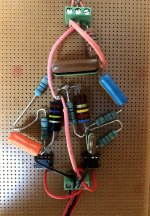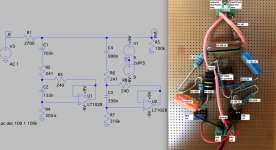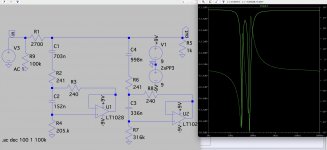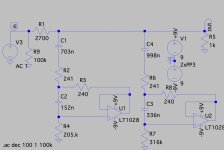I still don't understand what is playing below 100 Hz if the sub is turned off?
While impossible for me to feel confident in comparing the scope traces and the REW traces, it seems the notch is pretty wide - like 10-100 Hz. So the REW traces aren't so far off from what might be expected, given that notch and given the mysterious output you'd have anyway with the sub off.
Using REW to plot the electric output from the amp would let you put everything on the same chart.
B.
While impossible for me to feel confident in comparing the scope traces and the REW traces, it seems the notch is pretty wide - like 10-100 Hz. So the REW traces aren't so far off from what might be expected, given that notch and given the mysterious output you'd have anyway with the sub off.
Using REW to plot the electric output from the amp would let you put everything on the same chart.
B.
From about 69-78Hz and 90-104Hz the sub is making things worse. This could have a connection with position, or phase. (I'm not talking about the level of the peaks, but about interaction.)
Levels and EQ are in addition to that. If the sub is making things worse then the only way EQ can help is if it also happens to change phase by enough.
Levels and EQ are in addition to that. If the sub is making things worse then the only way EQ can help is if it also happens to change phase by enough.
I still don't understand what is playing below 100 Hz if the sub is turned off?
While impossible for me to feel confident in comparing the scope traces and the REW traces, it seems the notch is pretty wide - like 10-100 Hz. So the REW traces aren't so far off from what might be expected, given that notch and given the mysterious output you'd have anyway with the sub off.
Using REW to plot the electric output from the amp would let you put everything on the same chart.
B.
The main speakers are always playing so this is the mystery with and without the addition of the sub. The sub is hardly putting any output out over 100 Hz - it is set to roll off at about 70 Hz on the dial.
The point of the notch filter is to act as a notch, and if they are broad enough to work over 100 Hz then what's the point, just turn the sub down......
My thoughts were that something was amiss, and I have made an error somewhere, but if that's how wide they act my error is to believe the trace and the maths of a notch filter !
You could build this filter.
I have used it very succesfully in my system to suppress a few room modes.
Active Filters
Any ideas why there seems to be little effect at specific frequencies?
I am thinking i must have built it wrong somehow>?
Thanks,
Attachments
Is the notch filter in series with the main speakers?
Generally a real bad idea to burden woofer and mid-range drivers with playing low bass which requires big excursions of the cone, power input, etc.
Likewise for this testing, better to start with a simple configuration.
B.
Generally a real bad idea to burden woofer and mid-range drivers with playing low bass which requires big excursions of the cone, power input, etc.
Likewise for this testing, better to start with a simple configuration.
B.
Any ideas why there seems to be little effect at specific frequencies?
I am thinking i must have built it wrong somehow>?
Thanks,
Could you measure the frequency response at the output of the subwoofer power amplifier and at the output of the mains speakers power amplifier ?
Just to understand better what is happening.
The sub power amp internally has a lead that connects the preamplifier board to the power amplifier board and I have put the filter in series in between.
I atm only have facility to 'listen' to the speakers through REW and a microphone, but the trace shows that there is not any attenuation of the notch frequencies / my thinking is I have made some error of the notch filter itself?
I atm only have facility to 'listen' to the speakers through REW and a microphone, but the trace shows that there is not any attenuation of the notch frequencies / my thinking is I have made some error of the notch filter itself?
You really should have a buffer before and after the filter
It is possible that the pre-amp has a high output impedance which would add to your 2k7 input resistor and mess up your calculations. It is also possible that your sub power amp has a (relatively) low input impedance causing a general loss of signal, swamping the effect of the notch filter
In your sim, you have the pre-amp output impedance of zero, and your power amp input impedance to 100k. I doubt that either of these is correct
Brian
It is possible that the pre-amp has a high output impedance which would add to your 2k7 input resistor and mess up your calculations. It is also possible that your sub power amp has a (relatively) low input impedance causing a general loss of signal, swamping the effect of the notch filter
In your sim, you have the pre-amp output impedance of zero, and your power amp input impedance to 100k. I doubt that either of these is correct
Brian
Is the notch filter in series with the main speakers?
Generally a real bad idea to burden woofer and mid-range drivers with playing low bass which requires big excursions of the cone, power input, etc.
Likewise for this testing, better to start with a simple configuration.
B.
You really should have a buffer before and after the filter
It is possible that the pre-amp has a high output impedance which would add to your 2k7 input resistor and mess up your calculations. It is also possible that your sub power amp has a (relatively) low input impedance causing a general loss of signal, swamping the effect of the notch filter
In your sim, you have the pre-amp output impedance of zero, and your power amp input impedance to 100k. I doubt that either of these is correct
Brian
If you run the simulation with an additional input impedance and play with the values of these at input and output, gain changes but not the notch frequency.
Attachments
The sub power amp internally has a lead that connects the preamplifier board to the power amplifier board and I have put the filter in series in between.
I atm only have facility to 'listen' to the speakers through REW and a microphone, but the trace shows that there is not any attenuation of the notch frequencies / my thinking is I have made some error of the notch filter itself?
Yes, but still it is possible to measure the frequency response at the input of the mains speakers.
Yes, but still it is possible to measure the frequency response at the input of the mains speakers.
How do you do that - something like this?
A DIY approach to distortion measurements for audio amplifiers – (mis) Adventures in Hi-Fi
noted, but the input and output methodology will be the same I guess.
What was your past experience with these filters?
What was your past experience with these filters?
I have used this filter topology for room equalization with excellent results.
I found it in the Linkwitz site who also used it for equalization.
So there is no problem with the filter.
I found it in the Linkwitz site who also used it for equalization.
So there is no problem with the filter.
yeah it seems it can only be my construction somehow.......
how did the filters perform, matching the simulation reasonably well?
how did the filters perform, matching the simulation reasonably well?
Yes, I see the following:
1. You should use buffers at the input, between the two notches and at the output.
2. You should use also a resistor similar to R1 at the second notch.
3. A good buffer can be build with OPA2134.
The simulation always matches well with these kind of filtres.
1. You should use buffers at the input, between the two notches and at the output.
2. You should use also a resistor similar to R1 at the second notch.
3. A good buffer can be build with OPA2134.
The simulation always matches well with these kind of filtres.
I am away of my office these days, and I cannot use the LTspice to make the circuit.
I will be back this weekend.
Until then you could post your LTspice file, so it will be much easier to make the modifications.
Or you could modify the circuit and I could make my comments.
I will be back this weekend.
Until then you could post your LTspice file, so it will be much easier to make the modifications.
Or you could modify the circuit and I could make my comments.
- Home
- Loudspeakers
- Subwoofers
- Notch Filters to remove room modes



